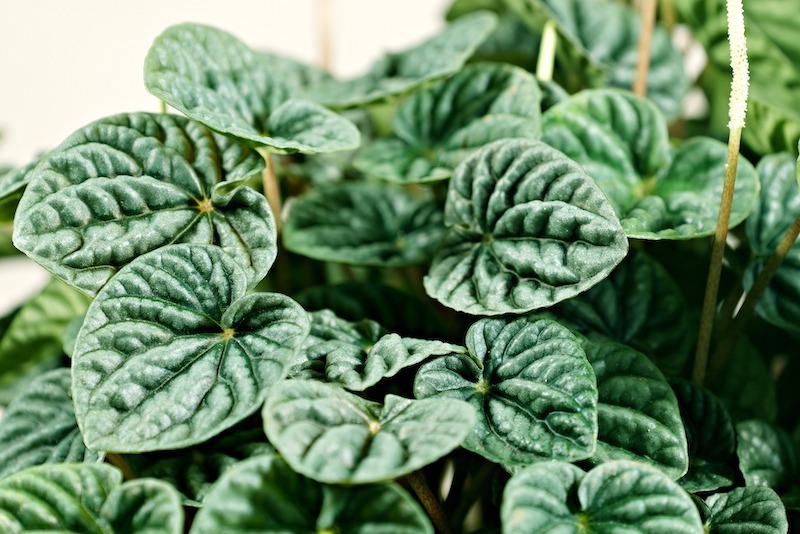Peperomia Is Dying
Peperomia thrives when maintained in optimal conditions. These include proper light, soil, water, fertilizer, temperature, and humidity. This tropical perennial flourishes when exposed to bright indirect light while preferably placed near an east-facing or north-facing window and avoiding harsh afternoon sun. Its soil should be well draining, loamy, and slightly acidic, a typical houseplant potting soil amended with perlite should do nicely.
This evergreen prospers in temperatures ranging between 65 to 80 degrees and humidity varying between 40% to 50%. Under these conditions, Peperomia usually needs only one watering per week or less. This slow grower does not require frequent feeding, but its nutrients can be replenished with a balanced, water-soluble fertilizer applied twice a month during its growing season.

To alert you that it needs first aid, Peperomia offers clues via its foliage. Identify the clue, determine the cause, and respond accordingly. Ignore normal behaviors, such as dropping old leaves to make room for new growth. Instead, focus on abnormal changes, including yellowing, curling, deforming, and wilting, and then make the appropriate adjustments. Too much water or light causes yellowing. Too little water causes curling and wilting. And, finally, deformed leaves are usually caused by pests and diseases.
Peperomia Leaves Turning Yellow
Factors that negatively affect this perennial’s ability to produce chlorophyll will cause yellowing leaves. Such factors include receiving insufficient amounts of water, nutrient-deficient soil, and too much light. First, adjust the watering schedule and ensure the soil is adequately draining. If the soil isn’t draining well, examine the container. Maybe a porous pot or one with larger drainage holes will help. If the plant seems too dry, increase the watering frequency. If watering doesn’t seem to be the problem, you can try feeding Peperomia a balanced (10-10-10) fertilizer. Finally, if you conclude that too much light is yellowing the leaves, put this evergreen’s chlorophyll factories back into production by moving it away from harsh direct light, which can cause sunburn.
Peperomia Pests
Three pests occasionally bother Peperomia: mealybugs, spider mites, and whiteflies. Mealybugs are non-winged insects coated with a wax-like substance. Clusters of white eggs indicate an infestation. Spider mites are arachnids and, similar to their namesake, weave webs. Their webs signify an invasion. Whiteflies are small, whitish-winged insects. Leaves turning yellow, dying, and falling off characterize their attack. All three soft-bodied pests can damage a Peperomia by removing juices from the plant. Mealybugs withdraw the juices from the plant’s phloem, and spider mites and whiteflies suck fluids from the leaves.
After spotting an infestation, take action immediately. Prune damaged foliage, and, to remove any loosely attached pests, wipe leaves with a moistened cloth or spray with a water bottle. To address a severe infestation, follow up by treating the foliage weekly with insecticidal soap or a horticultural oil such as Neem oil.
Peperomia Diseases
While Peperomia is typically disease resistant, look for signs of the following three conditions: fungal leaf spot, root rot, and ring spot. Fungi cause the first two, and a virus causes the third. Taking quick action will prove advantageous if you suspect your Peperomia is suffering from any of these. Darkish brown spots of dried foliage tissue characterize damage done by fungal leaf spot. Trim the damaged leaves and dispose of them immediately. Then, treat the plant with a fungicide such as Neem oil.
Root rot is a more complex problem to treat. It is characterized by the appearance of dark, mushy plant tissue. To treat, first assess the amount of damage. If severe, get rid of the entire plant. If only moderate, however, remove the plant from the pot and trim the damaged roots. Spray the remaining roots with a fungicide such as Neem oil. If using the same container, thoroughly wash it with a solution of 1:9 parts bleach to water. Refill the pot with new soil and replant Peperomia. Trim any remaining dead/damaged foliage and discard it. Finally, treat the foliage with Neem oil and wait to water until the soil is dry.
Ring spot is a viral disease that causes patches of brownish rings to appear on Peperomia’s foliage. Ring spot cannot be treated, so the only thing left to do is dispose of the plant.

Peperomia Not Blooming
Peperomia is typically famous for its verdant, sometimes variegated, foliage, not its flowers. However, various species occasionally bloom throughout the year, producing long flower spikes. These species are more likely to bloom in optimal conditions, including bright indirect light; moderate to high humidity; warm temperatures; and well-draining soil. They are also more likely to flower if maintained outside on a patio or deck rather than indoors.
 |
Author Suellen Barnes - Published 3-21-2023 |
